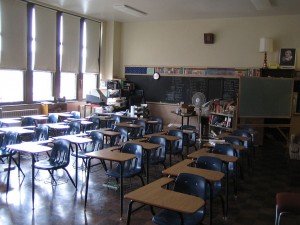Some state aid restored for schools
Kevin Beese — April 20, 2015
Statewide about 65 percent of school funding comes from the state. In Cook County suburbs, that figure is much less as more property tax revenue is pumped into schools. In some suburban districts as little as 10 percent of revenue comes from the state.
Officials in West Aurora School District 129 are glad state education leaders re-examined their cutting of state aid to school districts across the board.
Originally, it looked like the district of close to 13,000 students would lose close to $1 million in general state aid. After state recalculations, the district will get about $600,000 of that money back.
“It is still a reduction, but it is not as severe,” said Tony Martinez, director of community affairs for District 129. “It is bittersweet news. We are happy that it is not $1 million being taken away, but it is still a loss.”
When 2.25 percent was cut uniformly from general state aid for school districts, there was an outcry that all district are not on equal footing. Some could weather the loss of state aid better than others, poorer districts contended.
Statewide about 65 percent of school funding comes from the state. In Cook County suburbs, that figure is much less as more property tax revenue is pumped into schools. In some suburban districts as little as 10 percent of revenue comes from the state.
Hearing the GSA concerns, the state went back and looked at poverty numbers, districts’ amount of cash on hand and other figures to determine which districts still warranted GSA funds.
When the reallocation of general state aid was determined, West Aurora was one of 22 district in the state to get at least $500,000 in general state funding restored. A total of $77 million in general state aid has been restored to districts throughout the state.
While the West Aurora district had $764,210 in GSA funds restored, the state made cuts in other funding to the district.
“We got back more than $750,000 in GSA money, but they also cut a little here and there,” said Angie Smith, assistant superintendent of operations for the West Aurora district, noting that the school system lost $88,000 in special education transportation funding from the state. “There are little nicks.
“I am grateful that the state realized that all districts are not the same and looked at where the needs are greatest.”
Smith estimated that when the other cuts are measured against the $764,000 restoration in general state aid, the district will be somewhere in the vicinity of receiving $400,000 less in state aid overall.
She likened the back-and-forth moves with state education funding to a game of ping pong.
School districts getting back at least $500,000 in general state aid, labeled as “Hold Harmless” money for district with more students in poverty, limited cash on hand and other factors, are:
- Chicago Public Schools – $33.2 million
- School District U-46 – $2.1 million
- Rockford SD 205 – $2 million
- Waukegan Community Unit School District 60 – $1.6 million
- East Aurora USD 131 – $1.5 million
- Cicero SD 99 – $1.4 million
- Plainfield SD 202 – $1.3 million
- Joliet Public School District 86 – $1,1 million
- East St. Louis SD 189 – $941,302
- Oswego CUSD 308 – $900,019
- Peoria SD 150 – $883,068
- Springfield SD 186 – $797,500
- West Aurora SD 129 00 $764,210
- Valley View CUSD 365U – 757,842
- Indian Prairie CUSD 204 – $737,037
- Round Lake CUSD 116 – $719,390
- JS Morton SD 201
- Decatur SD 61 – $695,762
- CUSD 300 – $690,803
- Granite City CUSD 9 – $542,506
- Maywood-Melrose Park-Broadview SD 89 – $522,079
- Danville CCSD 118 $515,758
Still looming in the state Legislature is Senate Bill 1, which would dramatically change the school-funding formula. That formula would benefit West Aurora District 129 and many other districts. It would also take money away from wealthier districts.
“We would benefit substantially from Senate Bill 1,” District 129’s Smith said. “It would be good for us, but bad for our neighbors. I am not going to hold my breath. Something has to be done to change the funding formula, but lawmakers have been unwilling to do anything.”



